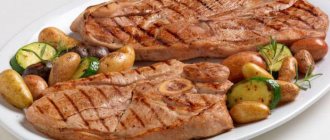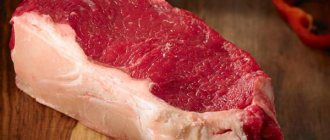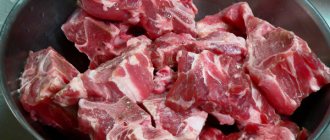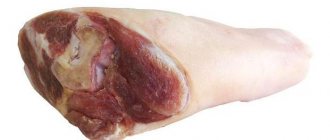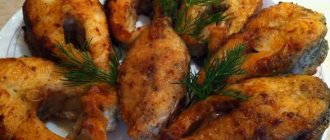Chateaubriand beef can rightfully be considered an ideal solution for a festive lunch and gala dinner. This exquisite and incredibly tasty haute cuisine dish will not leave anyone indifferent. If you have tried this aromatic dish in restaurants or with guests, then you will definitely want to have the Chateaubriand recipe on hand to impress your family and guests with this meat dish. We suggest using the classic French recipe and its variations to choose the perfect way to cook beef.
If you look at it, the recipe itself is very simple and consists of a fried beef steak. But in order to give beef a unique, recognizable taste, you will have to try a little and strictly follow the step-by-step cooking recipe. An important condition is the presentation of the finished dish. Chateaubriand goes best with a light side dish - fresh cucumber salad with cherry tomatoes, mushrooms, and baked vegetables.
Chateaubriand steak with baked vegetables
This meat is best combined with light and tasty side dishes, such as vegetables.
Therefore, this recipe will undoubtedly appeal to lovers of a balanced diet. Preparation time 10 min
Cooking time 40 min
Total time 50 min
Ingredients
- 400 g beef tenderloin
- 1-2 pcs. eggplant
- 2-3 pcs. tomatoes
- 1 PC. shallot
- 2-3 cloves garlic
- 3-4 pcs. White mushrooms
- 150 ml drinking cream
- 1 tsp butter
- 50 gr mozzarella cheese
- 30 ml vegetable oil
- salt, black pepper, parsley and rosemary to taste
Instructions
- The meat is washed and dried thoroughly. Then it is fried on both sides in a hot, oiled frying pan for a couple of minutes and placed on a baking sheet. Chateaubriand steak is baked for no more than 15-20 minutes at 180 degrees. You can also fry the meat in a frying pan with a lid, bringing it to the desired degree of doneness - this way the cut will be no less juicy.
- At this time, you can do vegetables. Eggplants must be cut into slices. At the same time, each piece is salted so that the excess amount of liquid is glassed off. Fry them in a hot frying pan with added oil for 2 minutes. Tomatoes are cut into proportional circles.
- A few minutes before the meat is ready, already prepared vegetables are placed in it. It is advisable to lay them out, alternating slices of tomatoes and eggplants.
- Top the vegetables with finely chopped garlic and rosemary. Cheese and a mixture of salt and pepper are also added. This will complement the taste of the Chateaubriand steak, making it unforgettable.
Notes
In addition to the steak, it is recommended to prepare sauce.
To do this you will need to chop the shallots and porcini mushrooms. They are simmered in butter, then the cream is poured in in a thin stream, stirring constantly. Cover the sauce with a lid and simmer over low heat for 2-3 minutes. At the very end of cooking, it is recommended to add finely chopped parsley and add spices to taste. Before serving, the Chateaubriand steak is cut into large slices. They are laid out along with a side dish, pouring mushroom sauce on top. BJU - 20-25% proteins, 50-55% fats, 20-30% carbohydrates. Calories: 250kcal
Dish: Main Course
Keyword: beef, Steak
Steak means "to fry"
True steak is usually cooked over an open fire. If you have a grill in your home, then mastering the art of cooking steaks is vital. It would seem that what could be simpler than frying a piece of meat? But in fact, this task is not an easy one. And not every professional chef can cook a steak correctly. To achieve perfection, you will have to practice. First, learn how to choose meat for a particular type of steak. Choose the optimal and harmonious ratio of spices and, of course, master the technology of degree of frying. It is traditional to cook beef steak. Chateaubriand is recommended to be made from bull meat. Remember that even a high-quality product that has been frozen will be significantly inferior in taste to fresh meat, so try to purchase it on the day of cooking.
What kind of steak is this
The presented version of the cut is in many ways similar to filet mignon. This part is also called the tenderloin or tenderloin.
The difference is that this is its thickest part, resembling a cylinder.
The name and idea of steak came to us from France. The aristocratic chef François-René de Chateaubriand invented the following method for preparing a large piece of boneless beef. He wrapped a piece of beef in comparatively lower quality steaks, tied it up and fried everything until charred. The perfectly cooked meat inside was called Chateaubriand.
Today, Chateaubriand is generally considered to be a large filet mignon cut. The steak is served with vegetables or potatoes with the addition of a special sauce.
CHATAUBRIDAN
CHATAUBRIDAN (Chateaubriand) Francois Rene de (4.9.1768, Saint-Malo - 4.7.1848, Paris; buried on the island of Grand Baie, near Saint-Malo), French. writer, government activist, member Franz. academy (1811). From the aristocratic family, spent his childhood in the family castle, studied at the colleges of Dole (1777–81), Rennes (1781–82) and Dinant (1783). In con. 1780s moved to Paris, where he witnessed and possibly took part in the storming of the Bastille. In 1791 he traveled to America, upon returning to Paris he joined the royalist army, and was wounded during the siege of Thionville; then lived in Belgium, and in 1793 emigrated to England. In 1800, after an amnesty, he returned to France; in 1803, the French. envoy to Rome; after the assassination of the Duke of Enghien (1804), he resigned and went into opposition to the regime of Napoleon I Bonaparte. In 1806–1807 he traveled to Italy, Greece, the Middle East, and Egypt; Until 1814 he lived in seclusion near Paris. He welcomed the Bourbon Restoration in 1814, was an adviser to Louis XVIII, and followed him to Ghent during the Hundred Days (1815). After the final fall of the Napoleonic regime, he was proclaimed a peer of France and state. minister (1815–16), headed the ultra-royalist w. "Le Conservateur" (1818–20). In con. 1810s – 1820s performed diplomatically. instructions, gradually moving away from conservative circles. In 1830 he abandoned the state. and societies. affairs, until the end of his life he lived alone in Paris.
He made his debut as a poet with an idyll in the spirit of classicism “Country Love” (“L'amour de la campagne”, 1790). Being short on funds during the English. emigration (mid-1790s), professionally turned to literature. creativity. In 1797 he published a book that largely continued the traditions of the Enlightenment. “Historical, political and moral experience on revolutions old and new, considered in relation to the French Revolution” (“Essai historique, politique et moral sur les révolutions anciennes et modernes, considérées dans leurs rapports avec la Révolution française”), in which he put under questioning the idea of social progress. In London, he began work on the treatise “The Genius of Christianity” (“Génie du christianisme”, 1802, abridged Russian translation, 1982), where he turned to the glorification of the Christian religion, which he perceived as the basis. source culture. The treatise, created in line with the polemics, will enlighten. a cult of reason, that is. to a degree anticipated the aesthetics of romanticism; He is characterized by increased attention to nature, Middle Ages. history and art (primarily Gothic), as well as to the inner world of a person - his feelings, fantasy, intuition. According to Sh., only Christianity helps a person to comprehend his own. life, understand its meaning and accept death; faith heals the suffering soul, directs it to salvation and bliss beyond the grave. As an illustration of his ideas, he included in the treatise the story “Atala, or the Love of Two Savages in the Desert” (“Atala, ou les Amours de deux sauvages dans le désert”, separate edition in 1801, Russian translation 1802), as well as “René, or the Consequences of the Passions” (“René, ou les Effets des passions”, separate edition in 1802, Russian translation 1805), which stands at the origins of the French. traditions of novels about “superfluous people” (B. Constant, A. de Musset, etc.). The problem is ecstatic. suffering and death for the glory of God in the center of the “Christian epic” in the prose “Martyrs” (“Les Martyrs, ou le Triomphe de la foi chrétienne”, 1809, Russian translation 1816) from the history of the first Christians in Ancient Rome. Themes of the “natural man”, courage, passion and honor dominate the stories “The History of the Last of the Abencerages” (“Aventures du dernier Abencerage”, created in 1810, published in 1826; Russian translation 1959; based on a plot from the Spanish - Moorish history) and “The Natchez” (“Les Natchez”, 1826; opera 1893; about the life of North American Indians).
Author of the book. “An Essay on English Literature” (“Essai sur la littérature anglaise”, 1836, abbreviated Russian translation 1982), memoirs “Grave Notes” (“Mémoires d'outre-tombe”, 1848–50, Russian translation 1851 ), treatises, essays, travel notes, etc. Sh.’s work, which has had a significant impact. impact on the development of French literature, was very popular in Russia in the 1st half. 19th century
French style serving
Mushroom sauce goes well with Chateaubriand steak. When serving, a large piece of meat is poured with sauce on the side. On the other side, lay out vegetables and complement it all with a glass of wine.
Source: userealbutter.com
Serving Chateaubriand steak with wine is highly recommended. It is advisable that it be dry - dry white wines, such as Chardonnay, are ideal.
The main thing is the right meat
All steaks differ from each other in only one thing - the part of the animal carcass from which the tenderloin is made. Chateaubriand is a steak that is prepared from the outermost, thickest part of the tenderloin, located closer to the tail of the animal. This cut has an irregular shape and is therefore more difficult to cook than any other steak. It is important that the inside has several degrees of roasting at once. The top crust should be well cooked and reliably hold all the juices inside. This is exactly what the French aristocracy believes a Chateaubriand steak should be.
Lifehacks for cooking
When frying steak, it is recommended to use the heaviest possible pan, such as cast iron, to ensure a good, crispy crust.
It would be best to use an oil with a neutral taste and a high combustion temperature. In this case, the crust will turn out as beautiful as possible. Most often this is canola or corn oil.
In addition to rosemary and parsley, you can use other types of herbs. It could be sage, thyme. At the very end of cooking, you can add a small amount of fresh basil.
It is recommended to serve Chateaubriand immediately after preparation. However, leftover meat can be stored for no more than 72 hours. You can heat the steak in any convenient way: in a frying pan or in the microwave. The main thing is not to overcook the meat.
Chateaubriand steak can be served with a variety of side dishes. Meat goes well with potatoes or, for example, fried green beans.
Cooking this beef cut is a pleasure. Chateaubriand steak always turns out tender and juicy. The ability to combine it with a variety of side dishes and complement the taste with different notes will allow you to decorate any table.
The degree of roasting matters
There are several types of roasting meat and you can use the one that suits you best. The classic Chateaubriand steak has a well-grilled crust. The following layers should be of varying degrees of doneness, from “full” at the edges to “rare” towards the center. Inside such a steak should have a thin streak of completely raw meat. If you don’t particularly like rare meat, you can keep the steak on the fire a little longer so that it is not raw inside.
First you need to fry the prepared tenderloin on a grill heated to 250 degrees. Fry the piece for 20 seconds on each side. This will form a crust on the surface, thanks to which the juices will be retained inside. Now you need to reduce the temperature to 180-200 degrees and bring the steak to the desired readiness.
To get a steak rare, it will take about 10-15 minutes, but for a higher degree of frying - 25-30 minutes. Don't forget to turn the meat over and brush it with vegetable oil to form an appetizing crust. The time for each steak will be determined individually; the meat can be of different weights and “ages”.
